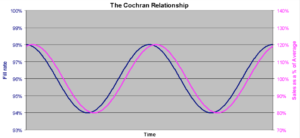Clients tell me that they can get fill rates up but they can’t keep them up, even if they throw inventory at the problem. When fill rates drop so do sales and turns. It is possible to get both fill rates and turns up and keep them up. Read on to understand the unexpected culprit. Most companies are caught in a delivery performance range that isn’t good enough to set them apart. Their customers, in other words, don’t see their fill rate as clearly better. It doesn’t matter what products or industry. Quoting Murphy’s Law: “Anything that can go wrong will go wrong.”
The shoe store doesn’t have my size. The bearing I need to stay in production is on backorder. The construction of my new home is delayed because the millwork is way behind schedule. The grocery is out of 2% milk. My stocking distributor is out of inventory. The container from China is stuck in customs. Supply chain disruption prevents me from meeting my promised delivery date to a customer who ordered in advance. Just-in-time became just-ran-out.
Sound familiar? We expect it. It is normal … more than normal … universal. It makes me think of a story that was told by a client back when we were courting them as a prospect. The client’s Operations Manager, Steve Cochran, had an insight. Steve said “We average 96% availability. It moves between 94% and 98% and we can’t break out of that range. When it goes up to 98%, our sales go crazy. When our sales go crazy, we start running out of products. When we run out, our fill rate drops down to 94%, which kills our sales. When our sales fall off, our fill rate improves back up to 98% and the whole cycle starts all over again.”

What Steve saw so clearly was how big the impact of availability is. We have seen this realization occur with so many of our clients that I now call it the Cochran Relationship: For every 1% change in availability, there is a 10% change in sales.
Like many Operations Managers, Steve was measured on fill rate and inventory turns. When asked about his measurements, he said that he was expected to get fill rates above 98%, which his current system could only briefly touch, and that the goal for turns could only be reached when sales were at the “crazy” level that they only saw when fill rates were at their highest. He said “It is a self-fulfilling prophecy. What goes up comes down. I’d be golden if I could just get my average to my peaks.”
Steve’s business is seasonally dependent on growing conditions. Since we can’t predict the weather, forecasts at the beginning of the season for each product are always too low or too high. However, once the season starts the forecasts start correcting based on the actual sales levels. In other words, the forecast lags behind reality. This means that the forecast is always behind. Is it true in all systems? Well, except when there is no variability in the system – no fluctuation in the rate of sales and absolutely reliable delivery from suppliers or manufacturing. Wait a minute! The only constant changes. Murphy’s Law is alive and well. Things go wrong. Therefore, it follows that forecasts must be wrong, at least by some amount, in all cases.
Forecast error adds to the normal variability that is built into the system. This is what W. Edwards Demming tried to teach us. If the forecast is excellent, it may only be 2% off. But, that 2% is the difference between a 98% and a 100% fill rate. And, according to the Cochran Relationship, that 2% is the difference between your current sales levels and120% of those levels.
Relying on forecasts robs companies of sales that could boost their profitability, depending on their margins, by 2% to 10% of their current sales. Changing to a “Pull” supply chain and managing inventory buffers dynamically according to actual demand, and allows companies to ignore their forecasts (except for rare extreme situations). Stop adding forecast errors into your system. Start satisfying your customers so well that they notice and talk about it. Be the competitor in your market space that has banished Murphy Law.
Remember: Availability is a solution for all seasons. For more information, visit www.neverrunout.com.
By: Henry Fitzhugh Camp, President of Shippers Solutions
